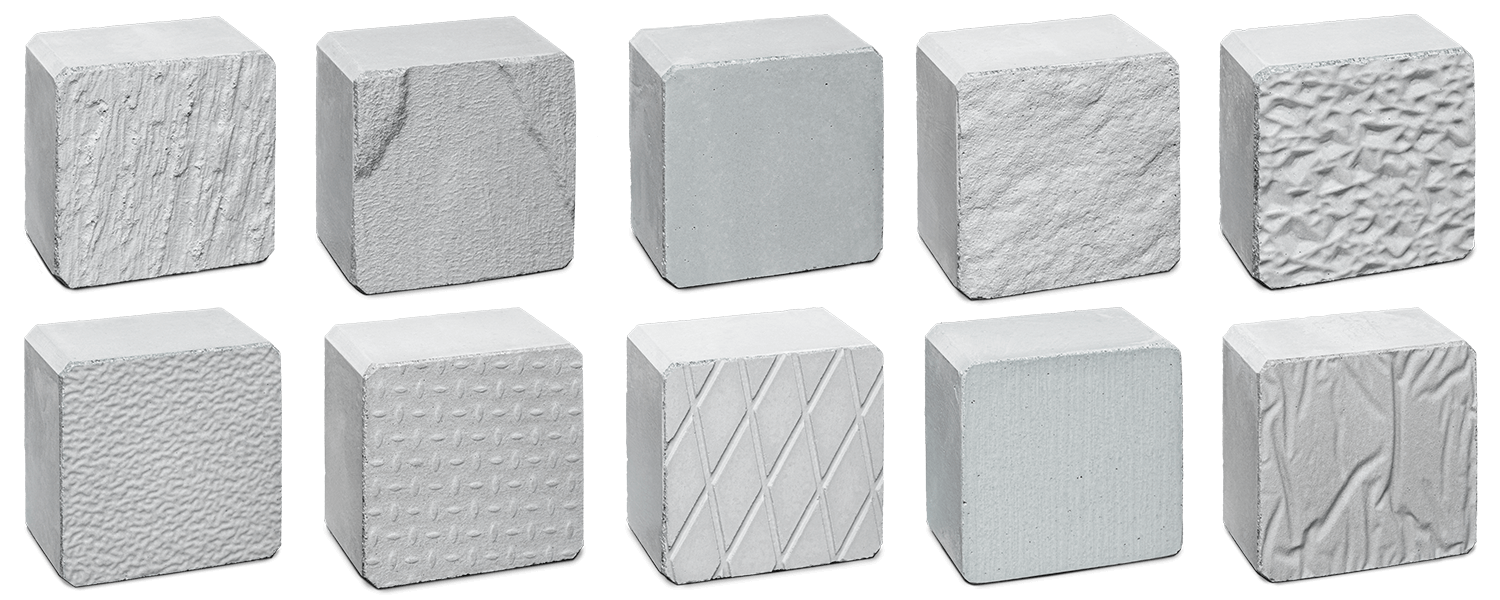MARO® FAQ
All of them! Our production can mix all colours that can be produced by pigments. Cones without pigments can be recognised by the designation concrete grey, basic grey or standard grey. All cones in our mock-up are in concrete grey. There are two procedures for matching the colours: We will gladly send you a selection of 20 different shades of grey, which can be compared with the concrete on site and selected, or you send us a sample of the desired colour and we will remix it in the best possible way. Almost all! To ensure that the surfaces of the MARO® plugs match your exposed concrete surface, we have 10 different surface patterns available. These include surfaces such as saw-rough and screen-print. In addition, we can also reproduce individual surfaces, such as special anti-slip profiles. To do this, simply send us a sample of the matrix used and we will check the manufacturability. The MARO® Sealing Cones are installed like standard sealing cones. Only when attaching them to the tie rod, care must be taken that the sealing ring is not pushed by the conus. This film illustrates the use. If you install the MARO® plugs with our MARO® adhesives, please note the following: Place the adhesive in the cartridge press. Open the cartridge carefully with a knife and turn the nozzle onto the cartridge. You can increase the delivery rate by shortening the syringe nozzle - you should approach this slowly. Pump the first few spurts of the cartridge onto a cardboard box. This will separate out any carrier fluid that may have settled. This depends very much on the size of the plugs. For the smaller plugs such as MARO plugs 22/10 and 22/05 we recommend approx. 1 - 1.5 cartridges per 100 pieces. For large plugs, such as those for steel plastic cones, you need approx. 3 - 4 cartridges per 100 pieces. The MARO®-FW adhesive for interior use has a general building authority test certificate and is non-flammable. We are happy to provide the test report. Unfortunately, the test set-up only allowed flaming up to F120, so use in higher requirement classes is not excluded. In all cases, the system should be agreed with the person responsible for fire protection in the building project before use. We have subjected our most common MARO® sealing plugs to a sound insulation test. We will be happy to provide this test report if required. The MARO® - Plugs for the MARO® - Sealing Cone 22/50/10 were successfully subjected to a water impermeability test in combination with our MARO® - Power Adhesive. We will be happy to provide the test report on request. All MARO® products are available from one of our nationwide distributors. Exemplary for plugs: If only the item number is given, it is a plug in standard grey with a smooth surface. All plugs, colours and surfaces can be selected with the help of the MARO® mock-up and combined as desired. Let us know when you have found your desired cone! We offer bespoke designs - even in small quantities. The interactive process is designed to allow on-site testing with plastic prototypes to try out different options before ordering the required quantity of concrete plugs. The Plug is the Sealing Cone that is installed in the hole and the MARO®-Cone refers to the Sealing Cone that is inserted at both ends of the tie point on the expansion tube. The Cone creates the hole that the Plug closes. Simple: Cone = Hole Plug = Closure We have a matching closure cone for all common nail plates from the manufacturer Philipp. This includes the KHN series, the KH products as well as the large nail plates of the "Wirbelstar" type. We have suitable locking cones for most common nail plates from the manufacturer Pfeifer. We have suitable plugs in various designs for the single-sided Peri-Maximo formwork system. This depends on the wall thickness. We also have suitable, high-quality plugs for other Peri installation parts. For the Framax Xlife plus exposed concrete cone 87mm, too, we can offer various exposed concrete plugs in a wide range of colours, finishes and also in variants such as recessed, with shadow gap or flush. Their design depends on the wall thickness. For other installation parts, such as climbing plugs, steel-plastic plugs or "normal" support plugs, we can offer MARO plugs. The reuse of sealing cones depends entirely on their condition when removed. As soon as the cones are scratched or deformed, they can no longer be used. The risk of them bonding too strongly with the concrete is too great. In general, the cones were not designed for multiple use - because the effort of sifting, sorting, cleaning and gluing on the sealing rings on site is not insignificant economically. Special colours can be purchased from one packaging unit. You can find colours in the topic above. When using formwork matrices with uneven surfaces. Additional sealing rings (available as blue replacement rings) can help to compensate for these unevennesses. However, it is imperative to test this beforehand - as it depends strongly on the type of matrix and the clamping torque of the tie points. Many formwork systems for one-sided anchoring can be used without cones and expansion tube. Due to the conicity of the tie rod, it can be detached from the wall and does not need an empty tube for this. If so-called magnetic cones are also dispensed with in this case, the tie rod leaves an unsightly, small conical hole. This is still surrounded by the circular reinforcement of the formwork. This hole cannot be closed satisfactorily - according to our understanding of high-quality exposed concrete. Therefore, we recommend the use of magnetic cones, as these allow a variety of optically suitable closures.
What colours are available?
Which surfaces are available?
How do I install the sealing cones correctly?
How do I install the plugs correctly?
As soon as a normal viscous amount comes out of the cartridge, you can start gluing.
First form a small plug of adhesive in the clamping tube. Then draw a macaroni-thick bead of glue along the wall of the conical opening.
Put the cartridge aside and now slowly turn the glue into the opening. This allows the air to escape from the clamping tube and the sides of the stopper are enclosed by the glue. How much glue is necessary?
What about the flammability of the plugs and adhesives?
The MARO® plugs are also classified as A1 material. As a system with a plastic spreader, we have successfully subjected our most common plugs, installed with the MARO®-FW adhesive, to an F120 flame test by the Erwitte Materials Testing Institute.
What can be said about the sound insulation of the plugs?
Are the tie points waterproof?
Where can I buy MARO® products?
In addition to site-specific logistics, our dealers also provide on-site support and advice. Would you like to know which dealer is near you? Mail us - we will be happy to put you in touch. E-Mail How do the article numbers work?
Can bespoke items also be manufactured?
What is the difference between MARO® Plug and MARO® Cone?
Which plugs fit Philipp mounting plates?
Which plugs fit Pfeifer retaining plates?
Which plugs fit Peri-Maximo?
Both for the MX 15-55 magnetic cone and the MX DR 22/2 cone. If only the "naked" tie rod is used, this results in a rather modest tie pattern - but we also have a small conical plug available for this. Which sealing plugs fit the Doka X-Life?
If anchoring is only carried out with a "bare" anchor, we have sealing cones available for the conical opening. Can sealing cones be reused?
Minimum purchase for special colours
Do MARO sealing cones also work on formwork matrixes?
Why does MARO recommend additional installation parts when using formwork systems with one-sided anchoring.






